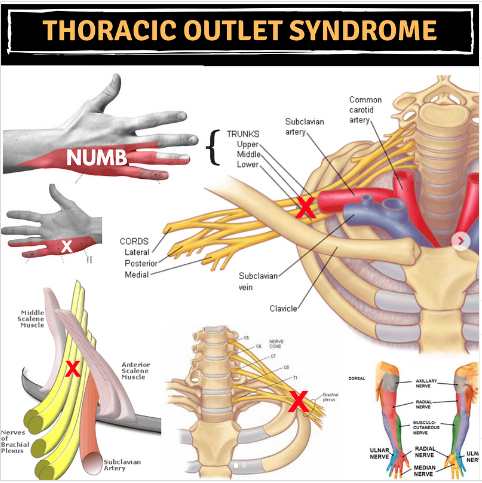Book Your Comprehensive NeuroStructural Examination
Thoracic Outlet Syndrome Diagnosis and Relief | Dr Alex Ritza Toronto Chiropractor
There are some diagnoses that practitioners make that very accurately describe what is going on but do not describe “why it is going on”.
Thoracic Outlet Syndrome (TOS) is one of them. It is compression of the nerves (sometimes arteries) leaving the neck when entering into the upper limb through the thoracic outlet: the space between the collar bone and the upper ribs.
Specifically, it is usually the lowest nerves leaving the neck from the C7 and T1 vertebrae that join together to form the lowest (inferior) trunk of the brachial plexus. These nerves then go on to provide sensation and muscle function to the inside of the forearm and hand (fourth and fifth finger) amongst other things.
The most telltale sign of TOS is numbness along the inside of the forearm and the smallest two fingers when the inferior brachial plexus trunk is compressed. Weakness could and usually does come later without proper care or relief. Sharp shooting, lancing or burning pain is an indication of actual nerve injury called neuropathic pain.
In the vast majority of cases, there is irritation (without damage) of these nerves causing numbness, and irritation of the muscles and joints near the thoracic outlet but very rarely is nerve damage the actual source of pain.
COMPRESSED or ENTRAPTED NERVE = NUMBNESS 🧠
What is the cause of Thoracic Outlet Syndrome?
I don’t like using the diagnosis of TOS because it does not explain WHY these nerves are compressed. It is likely telling someone they have a headache; they know they have those symptoms but we want to know why!
❓Is it because of tight scalene muscles that these brachial plexus nerves run between only?
❓ Is it because of a cervical rib that shouldn’t be there?
❓Is it because of degeneration in the cervical spine?
❓OR is it because all of the above combined with a forward SHIFT in the normal structure of the neck and a significant structural distortion? Poor posture or a structural shift will make the thoracic outlet smaller and more difficult for these nerves to pass through without irritation
The key is to know why it is happening and address the underlying Core Problem with the spine / nervous system.
If you only manage the symptoms then you are going to be constantly trying to release tight muscles and soothe irritated nerves without addressing the root cause of that irritation in the first place.
Imagine it is a structural issue (the neck/head is positioned too far forward) and that is the underlying cause. No amount of massage of the scalenes is going to fix it. If the head is constantly SHIFTED forward then it is going to create a lot of issues in the thoracic outlet that will keep coming back.
Fixing Thoracic Outlet Syndrome
I have attached one of my favourite drills that will hopefully provide some temporary relief.
View this post on Instagram
If your TOS is because of tightness in the scalene muscles and that is the underlying problem then the chair stretch is going to often prove to be very effective!
If the cause of your thoracic outlet syndrome is more structural or related to the health of the joints of the neck and upper rib cage then seeing a professional is a must. This is what we help people with every day at our office and there is no need to suffer!




